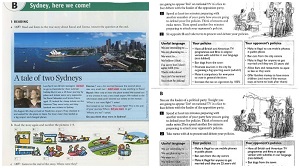
What is it?
Communicative language teaching (CLT) is an approach to language teaching that emphasizes interaction and communicative competence as the main goal of study. It consists of learners working in pairs or groups using language resources in problem-solving tasks.
Communicative approaches generally consist of two parties involved in an interaction where one party has an intention and the other reacts or expands on it. Since the communicative method is a broad approach rather than a specific teaching methodology, it appeals to many practitioners who interpret it in different ways. Howatt (1984) distinguishes between a “strong” and a “weak” version of CLT.
The “strong” version claims that language is acquired through communication, while the “weak” version (which has become standard practice nowadays) stresses the importance of using the language for communicative purposes within a wider program of language teaching. In other words, while the “weak” version means “learning to use the language”, the “strong” version entails “using the language to learn it.”
The learning theory behind this approach is that “activities that involve real communication promote learning.” Consequently, learning activities are selected according to how well they engage the learner in meaningful language use.
This led to the creation of communicative syllabi, consisting of a combination of structural and functional items like a) situations where learners typically need to use the L2 (e.g travel, business) b) topics they need to talk about (e.g education, shopping) c) the functions they need the language for (e.g describing something, requesting information) d) vocabulary and grammar.

A communicative syllabus © New English File
What are its activities?
The range of communicative activities is very large, provided they engage the learners in communication and require the use of the language for information sharing, negotiation of meaning or interaction. Some examples are: information gap, dialogues and role-plays, interviews, debates, or language exchanges. Richards and Rodgers (2001) classify communicative materials into three types:
- Text-based. Most current textbooks feature a syllabus with functional and structural content which is carried out through units containing a) real-world or adapted texts with comprehension questions b) communicative activities for pair work or group work and c) grammar explanations with grammar exercises (e.g fill in the gaps).
- Task-based. These consist of games, role plays, cue cards, activity cards, or pair-communication practice materials. They come in the form of “activity packs”, “workbooks”, or simply appear as an appendix at the end of the textbook.
- Realia. Real-world material which can be magazines, newspapers, and visual sources around which communicative activities can be built, such as maps, pictures, symbols, graphs, and charts.

Text and task-based materials © New English File
Criticism
Communicative approaches (in their strong version) have a great appeal because of the implication that learning by talking means “not learning grammar.” However, since language is composed of grammar, trying to learn a L2 without grammar is like trying to learn math without numbers.
Whenever you learn a language you are learning grammar either deductively or inductively. But learning grammar “inductively” (e.g through the context) does not mean not learning at all. In fact, the more inductive the learning, the more you have to turn to your analytical skills. In other words, the less you understand, the more you have to figure out what it means.
This is why communication alone is not “the key” to learning a L2. As Swan (1985) points out, “grammar has not become any easier since the communicative revolution.” There is a difference between learning and practicing with the language. Throwing balls over a net does not mean that you’re learning how to play tennis. This is why it is important to combine communication with form-focused instruction and activities to provide scaffolded learning.
Summary
Although in practice they tend to overlap, here’s a summary of the most noticeable differences between the four most common language learning approaches:

Sources
Howatt, A. P. R. (1984). A History of English Language Teaching. Oxford: Oxford University Press.
Richards, J., & Rodgers, T. (2001). Approaches and Methods in Language Teaching. New York: Cambridge University Press.
Swan, M. (1985). A critical look at the Communicative Approach (2). English Language Teaching Journal, 39(2), 76–87.



Najah
great job
Habib
Thank you for the chart in particular! I was confused but now things are cleared up.